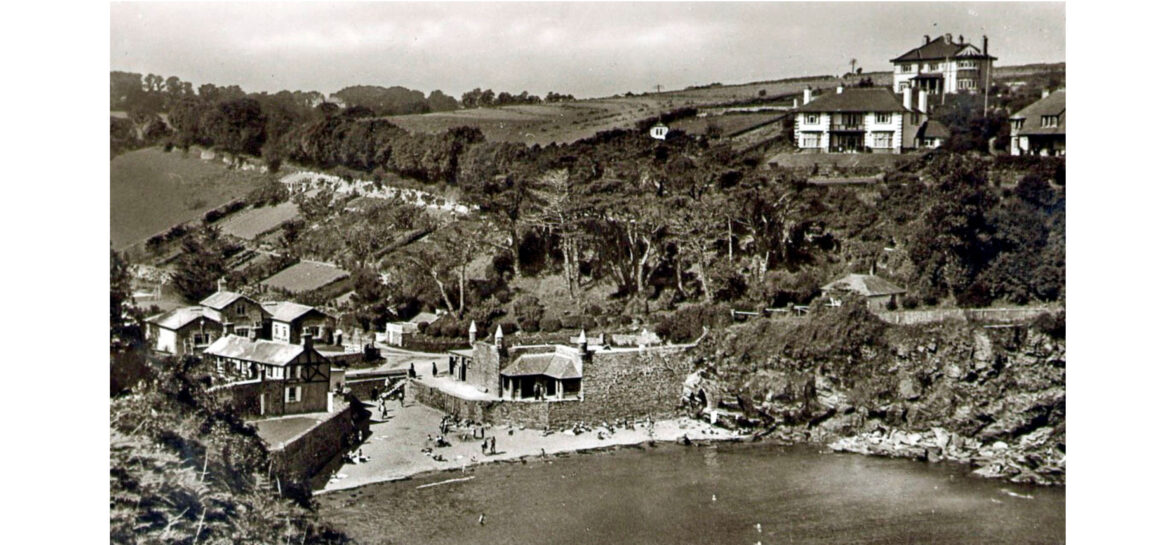
The peaceful and pleasant scene of Readymoney Beach, Fowey, portrayed here is in complete contrast to the event which Muriel Mansell relates in this true story. A story of a young girl who chose to resolve her problems in the only way she thought possible. Thankfully, few of us will experience such a horrific and tragic event but Muriel did, and the unanswered questions remained with her for the remainder of her life.
We were in no great hurry, my sister and I, as we left our home in Point Neptune Cottage. Just below us was Readymoney Beach where we played and learnt to swim. As usual, we waved goodbye to our mother as we walked out of the gate before ascending the short, steep hill that led to the easier terrain that was the Fowey Esplanade.
This was our daily journey and we knew exactly how long it would take to reach our school. Unless it was raining, there was always time to pause to watch the boats ploughing through the water as they moved up and down the river. Every day of our young lives had been spent looking out over the blue-grey waters of the Fowey River. Despite that, we never tired of it, it was a part of us, it was where we belonged.
If we thought that this day would be no different from any other then how wrong we were. It would involve us in an event that was so tragic that it would be etched on our memories for the rest of our lives.
I can’t be certain of the year, maybe it was 1928 or 1929 which would make us about nine years old. We were twins, Kathleen and I, a bit inquisitive, mischievous even, as we made our way along the Esplanade. We were in good time, time enough to sit above Polly Foot’s Cove and look down at the waters breaking over the rocks far below. We were chatting, with each other and with friends, but our attention was diverted by a young woman pushing a pram on the other side of the road. She paused to sit on the wall, resting perhaps or maybe waiting for someone. Anyway, it was time for us to move on: there were strict rules about punctuality and we dared not be late. We gathered up our school things and began to move away but before we did the young woman wheeled the pram across the road towards us. As she drew level, she tipped it slightly so that we could see the baby. She was clearly proud of the child and seemed pleased that we had taken an interest in it. Despite this friendly gesture she did not speak and suddenly, with no warning, she was gone. She had placed her foot on the pram wheel and thrown herself over the cliff.
It had happened so quickly and we stood there in disbelief. The pram with the baby was still there but the young woman was gone, almost certainly smashed to pieces on the rocks below. Perhaps, by gaining our interest, she had felt that the baby would be safe in our care.
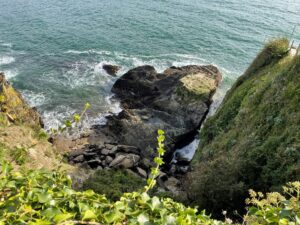 Polly Foot’s Cove
Polly Foot’s Cove
It seemed as though only a few seconds passed before help arrived including our father who worked nearby, at Point Neptune House, the home of the Reverend Cotes. He told us not to look and sent us on our way to school. In a daze, we moved off and left the men to their grim task.
When we returned from school our father refused to talk about the incident and even rebuffed our questions.
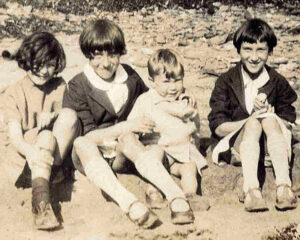 The twins: Muriel second left and Kathleen on the right
The twins: Muriel second left and Kathleen on the right
This then, is an account of a traumatic event in my life. I am left with many questions: the identity of the young woman, what led her to take her life and what became of the baby.
It has been suggested that the name “Polly” related to the young woman but that location was known as Polly Foot’s Cove long before this incident so that cannot be the case.
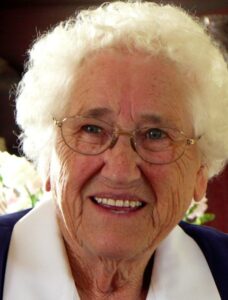 Muriel Merrifield was born in Point Neptune Cottage, Fowey. She married William Bunney, a Fowey boatman and merchant sailor, who was killed in the Second World War. A few years later she married Douglas Mansell of Truro and remained in mid-Cornwall until her death in 2016.
Muriel Merrifield was born in Point Neptune Cottage, Fowey. She married William Bunney, a Fowey boatman and merchant sailor, who was killed in the Second World War. A few years later she married Douglas Mansell of Truro and remained in mid-Cornwall until her death in 2016.
Perhaps this article will elicit a response to the questions: too late to satisfy my mother’s curiosity but it would provide some closure for me. (Tony Mansell, Muriel’s son)
That was the end of the story as far as I was concerned but responses to this poignant occurrance kept on coming and some of these have been added below:
“Dear Mr Mansell,
Fowey Library passed your query to our local history group. On discussion it seems that there is no definitive answer, some saying a girl threw herself over and survived, but it does seem to have been a suicide spot over the years. I looked up the name Foot in the deaths register and there were a few in the 1700s but hardly any after the beginning of the 1800s. The name Mary was common, and on talking to one of the librarians she said her grandmother was Mary but was always called Polly. This led me to look at a book of newspaper articles by the late Isabel Pickering, where I found a report of a suicide at Pollyfoots written on 24th Oct.1867 in the Royal Cornwall Gazette, so it was certainly named by then. Further back on July 4th it reports, Mary, the wife of William Foot of Fowey, fell from a high cliff there, into the sea and was unfortunately drowned: this was 1812. Could this be the Polly Foot? Perhaps it was called it after this tragedy and Mr Foot moved away. The Harbour Office no longer keeps records here so we cannot check anything there. It certainly seems a coincidence. Clearly, though, your mother was right about it already being called Polly Foot Cove when the poor young woman made her tragic leap.
Kind regards, Tessa Williams of the Fowey History Group.”
Then, from Cornish historian, Susan Coney, these newspaper reports which must surely relate to this event. Unfortunately, the time of day doesn’t tie up but this could be due to my mother’s memory (she was 96 when she died) or to a reporter’s careless pencil.
 Cornish Guardian of the 22nd December 1927
Cornish Guardian of the 22nd December 1927
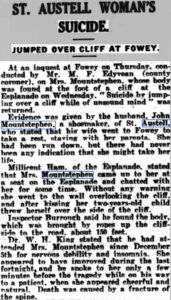
Cornish historian Barry West knew of the occurrance but his interest was in the girl who gave her name to the cove – Polly Foot.
The Worshipful Master
So they went over the Daglands, on to the Esplanade, and past the Castle Cove.
The moon had just risen, and the Fort frowned blackly beneath them.
There had been a storm outside, no doubt, for the waves were dashing over the rocks far below, and the white foam, gleaming ‘neath the moonbeams, looked awfully suggestive of peril.
They stood and gazed for awhile in silence and at last he said, quietly:
“Do you remember three years ago?”
“Oh! yes. I never forget.
Do you know I think you must have seen Polly Foot that night,” she added playfully.
“And who was Polly Foot?”
“Shall I tell you?”
“Yes; pray do”
“Well I will give it to you in my grandfather’s own words.”
“Who, the dead poet?”
“Yes;” and then, in her mellifluous voice, she told the legend of the Castle Cove:
Castle Cove: A Legend of St Mervin
(About a hundred feet below Belle Vue, Fowey is a great chasm (the cliff covered with verdure to the water’s edge) known as Polly Foot’s Cove, where the tragedy occurred, many years ago, related in the poem. It is situated close to the old ruined fort built in the reign of Edward III., and the view, looking over the gap up the harbour on a moonlight night, is very weird and picturesque. More than one suicide has taken place here.)
Would you see the autumn sunset, with its glamour and its glory
The lofty hills all purple with the heather in its bloom?
Will you listen while I tell you of the old, the olden story,
of a love that never faded – of the love beyond the tomb?
Would you come here where I can show you the fierce sea-horses leaping,
Tossing their white crests of foam against the sullen cliff?
Where the waves are idly plashing, and the foam is crawling, creeping,
Where the moonbeams show a something lying cold, and stark, and stiff?
For not many years ago, where you and I are standing,
Looking at yon fortress, beneath the harvest moon,
A woman sprang, with fearful leap, where foothold non nor landing
Could ever srve to save from death, that death that came too soon.
She loved and was deserted, and with her babe she hastened,
One night, away from home in desolate affright;
For he was dead, they told her: by grief she was not chastened,
But only in despair she fled, that lovely autumn night.
He was a hardy seaman; perhaps he had repented;
but sailors, saith the poverb, leave a wife in every port,
This had been their trysting-place, be sure ’twas oft frequented,
ans she had loved too well to know with him ’twas cruel sport.
The hungry sea it took him; her name he kept repeating;
they heard him call her “Mary!” before he sank at last;
And so, poor soul, her reason left hr – him she would be meeting,
And through the iron gate of death she’d keep her tryst at last.
Perhaps ’tis but illusion, light through the mullions gleaming,
A shadow from the autique window all athwart the rocks,
But strangely like a woman lying where the gulls are screaming
Below us, where the waves beat, with their booming and their shocks.
For these two shuddering souls, they say, do vainly wander
Amongst the caves and crannies within the Castle Cove,
And may be seen where moonbeams glimmer. Hist! what is that yonder?
We’ll leave this gruesome, haunted place, and here no longer rove.
As she said the last words she touched his arm, and he half started, as though he really expected to see something.
“Why,” he said, “you positively made me shudder.”
(By Emra Holmes)

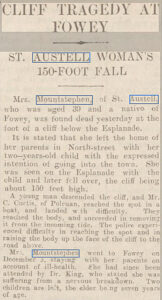
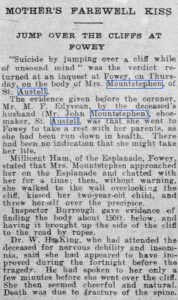
I visited Fowey last week, and took a walk down the Esplanade. I saw a new house called Pollys Leap and wondered how its name had originated. Your article provides a great insight into a truly tragic event. I do wonder what happened to the baby and family after losing their mother. Thank you again for publishing a really interesting and insightful piece.